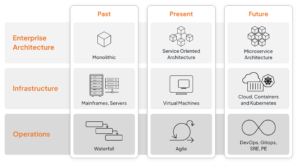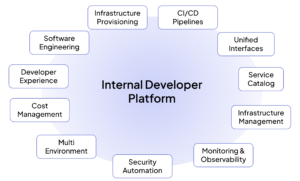
Application modernization has become a critical initiative for organizations looking to remain competitive in today’s rapidly evolving digital landscape. As businesses embrace cloud computing, microservices and AI-driven automation, modernizing legacy applications is no longer optional. It’s essential for scalability, agility and innovation.
However, modernization is not just about re-platforming applications; it requires a shift in both software engineering practices and software delivery processes. Organizations must adopt DevOps principles, automation and developer-centric platforms to manage the increasing complexity of modern software systems.

Figure 1: Application modernization requires changes in architecture, infrastructure and operations
This is where internal developer platforms (IDPs) play a crucial role. An IDP provides a standardized, self-service environment that enables developers to focus on building and shipping code efficiently, without getting bogged down by infrastructure concerns. In this article, we will explore why enterprise modernization is necessary, the role of engineering and delivery practices, and how an IDP can be the key to unlocking modernization success.
The Need for Enterprise Application Modernization
Many enterprises still rely on monolithic, legacy applications that were built decades ago. While these systems have served their purpose, they now pose several challenges:
- Lack of scalability – Legacy applications struggle to handle modern workloads and high availability requirements.
- High maintenance costs – Older systems often require expensive upkeep, and skilled professionals capable of maintaining them are becoming scarce.
- Security risks – Outdated architectures are more vulnerable to breaches and compliance risks.
- Slow time-to-market – Changes in monolithic applications take longer to implement, delaying innovation.
To address these challenges, organizations are shifting towards modern application architectures that leverage:
- Cloud (hybrid, multi-cloud, serverless) for greater flexibility.
- Microservices and APIs to enable modularity and agility.
- Containerization (Kubernetes, Docker) for scalability.
- AI-driven automation to enhance efficiency and observability.
While these technologies promise modernization benefits, they also introduce new complexities in software engineering and delivery. Enterprises need structured, automated and developer-friendly platforms to manage these complexities effectively.
The Role of Software Engineering Practices in Modernization
Enterprise modernization is more than just migrating applications; it requires a fundamental change in software engineering approaches to ensure maintainability, scalability and security. Key practices include:
Modular Architectures
Legacy monoliths are being replaced with microservices, event-driven architectures, and APIs to enable independent scalability and deployments.
Infrastructure as Code (IaC)
IaC tools like Terraform and Pulumi allow teams to automate and version-control infrastructure, ensuring consistency across environments.
DevOps and GitOps
Adopting DevOps and GitOps enables teams to standardize deployments, rollback changes safely and manage configuration as code.
Security-First Development
Security must be integrated from the start through shift-left security practices, Zero Trust architecture, and Software Bill of Materials (SBOM) for supply chain security.
However, implementing these practices across a large organization is challenging without a unified, self-service developer experience. This is where IDPs play a critical role, providing a streamlined, automated environment that enables teams to adopt modern engineering practices seamlessly.
Software Delivery Challenges in Modernization
Modernization not only changes what enterprises build, but also how software is delivered. While DevOps and CI/CD pipelines have improved automation, many organizations still face challenges such as:
- Managing multiple environments (development, testing, staging, production) consistently.
- Bottlenecks in CI/CD pipelines, where slow approvals and manual interventions delay releases.
- Inconsistent developer experience, leading to inefficiencies across teams.
- Regulatory and security compliance concerns that slow down deployments.
Enterprises need a way to streamline software delivery while enforcing best practices, which is a role that IDPs excel at.
The Internal Developer Platform (IDP) as a Solution
What is an Internal Developer Platform (IDP)?
An IDP is a self-service, infrastructure-agnostic platform that provides developers with everything they need to build, deploy and manage applications efficiently.
An IDP enables:
- Standardized environments across development, staging, and production.
- Self-service capabilities for developers to deploy applications without waiting on ops teams and within the said guardrails of the organization.
- Automation of workflows for security, compliance and governance.
- Abstraction of infrastructure complexities, letting developers focus on their apps rather than configuring infrastructure.

Figure 2: Functionalities of an IDP
How an IDP Streamlines Software Delivery
IDPs bring together best practices in software delivery by:
- Abstracting infrastructure complexities – Developers don’t need to manually configure Kubernetes, networking, or CI/CD pipelines.
- Creating golden paths – Standardized templates and best practices reduce cognitive load for engineers.
- Automating security and compliance – Built-in policies ensure regulatory requirements are met from the start.
- Integrating AI-driven insights – Intelligent automation helps optimize workflows and detect issues proactively.
By providing a unified experience, IDPs accelerate modernization efforts and enable enterprises to ship software faster and more securely.
How an IDP Helps Cloud-Native Software Engineering
Cloud-native applications introduce complexities with Kubernetes, microservices, and dynamic infrastructure. An IDP simplifies cloud-native software engineering by:
- Enforcing cloud-native architecture: IDPs provide standardized templates for cloud native software architecture. This helps engineering teams to build modern cloud native applications.
- Simplifying and strengthening application security: The exposure landscape of modern distributed applications is vast. An IDP ensures modern applications are provided with end-to-end security using Firewalls, API gateways, network level encryptions, mutual-trust and RBAC.
- Promoting sharing and reuse: An IDP provides a framework for easy sharing and reuse of services and applications through service catalog and developer portals. This process significantly reduces rework and zombie endpoints running in an organization.
- Enforcing standards and best practices: IDPs provide governance frameworks to help developers build applications that follow organizational best practices, standards and compliance guidelines.
- Enhances Developer Experience: Self-service workflows streamline access to CI/CD, logging, scaling and security policies, reducing reliance on ops teams.
- Improves Observability and Performance: Integrated monitoring, tracing and alerting help engineers debug and optimize cloud-native apps.
By removing infrastructure burdens and standardizing cloud-native workflows, an IDP empowers engineers to build scalable, reliable and secure applications efficiently. It enables organizations to modernize faster, reduce cognitive load and focus on innovation.
Implementing an IDP for Modernization
Key Considerations When Adopting an IDP
- Alignment with organizational goals – Ensure the platform supports business objectives.
- Build vs. buy decision – Some enterprises build custom IDPs, while others use managed solutions.
- Cross-cutting impact – The IDP should help organizations modernize their architecture, infrastructure and operations.
Measuring Success: Key Metrics
To track the impact of an IDP, organizations should monitor:
- Deployment frequency – Are teams shipping features faster?
- Lead time for changes – How long does it take from commit to production?
- Mean time to recovery (MTTR) – How quickly can failures be resolved?
- Developer net promoter score (NPS) – How satisfied are developers with the platform?
- Reduction in TCO – Is your total cost of ownership going down significantly?
Conclusion
Enterprise application modernization is no longer a luxury—it is a necessity for organizations looking to scale, innovate and remain competitive. However, modernization is not just about moving to the cloud; it requires a shift in engineering and software delivery practices.
An internal developer platform (IDP) is a critical enabler in this journey. By providing standardization, automation and self-service capabilities, an IDP reduces complexity, accelerates delivery and enhances developer productivity.
As enterprises continue modernizing, platform engineering combined with IDPs will define the future of software delivery, making it more efficient, scalable and secure.
If your organization is embarking on a modernization journey, investing in an IDP is one of the smartest strategic moves you can make.
KubeCon + CloudNativeCon EU 2025 is taking place in London from April 1-4. Register now.
